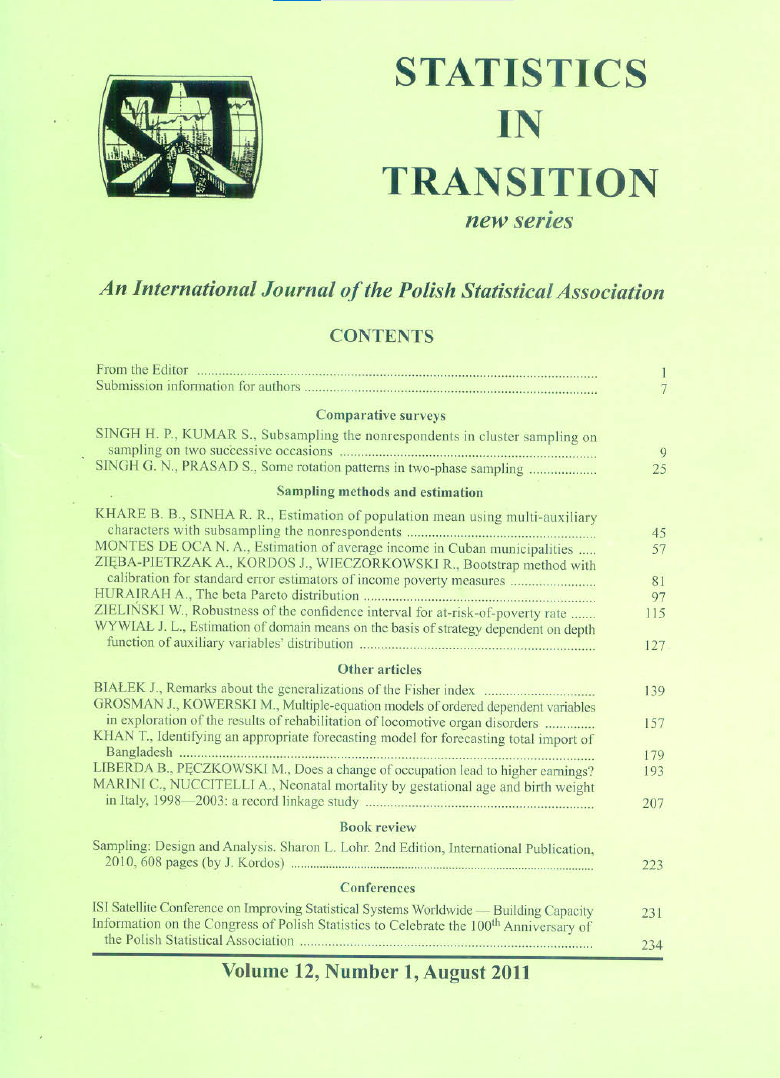ARTICLE
ABSTRACT
The authors begin with calibration approach in sample surveys, focussing on the Eurostat approach. Next, the indicators of poverty and social exclusion are discussed as an essential tool for monitoring progress in the reduction of these problems. Most of these indicators are calculated according to the Eurostat recommendations, using data from European Statistics on Income and Living Conditions (EU-SILC). Complex sample design of the EU-SILC requires weighted analyses for estimates of population parameters and approximate methods of standard error estimation. In our study McCarthy and Snowden (1985) bootstrap method for standard errors estimation of income poverty measures is presented. In the next step the reweighting of bootstrap weights is applied and results of such calibration are discussed.
KEYWORDS
Auxiliary information; Bootstrap, Calibration, Complex sample surveys, EU-SILC, Poverty indicators; Weighting
REFERENCES
CANTY A.J., DAVISON A.C.,(1999), Resampling-based Variance Estimation for Labour Force Survey, Journal of the Royal Statistical Society. Series D (The Statistician), Vol. 48, No. 3 (1999), pp. 379-391.
DEVILLE, J.-C. and SARNDAL, C.E. and Sautory, O. (1993), Generalized Ranking Procedures in Survey Sampling, Journal of the American Statistical Association, Vol. 88, No. 423, pp. 1013-1020.
EFRON B., (1979) Bootstrap methods: another look at the jackknife, "Annals of statistics" 7, 1-26.
EUROSTAT, (2002), Estimation Techniques in Statistics - A Methodological Note on Calibration.
EUROSTAT, (2004), Description of target variables: Cross-sectional and Longitudinal, EU-SILC 065/04, pp. 31 - 36.
EUROSTAT, (2005), Continuity of indicators between end-ECHP and start-SILC Algorithms to compute cross-sectional indicators of poverty and social inclusion adopted under the open method of coordination.
EUROSTAT, (2009) Methodological studies and quality assessment of EU-SILC, Report SILC.04 15 April 2009, SAS programs for variance estimation of the measures required for Intermediate Quality Report.
GAMBINO J., (1999), Discussion of "Issues in Weighting Household and Business Surveys", Proceedings of the 52th International Statistical Institute Session, Finland.
GUS, (2009), Incomes and Living Conditions of the Population in Poland, report from the EU-SILC survey of 2007 and 2008, Warsaw.
KORDOS J. , ZIĘBA-PIETRZAK A., (2010), Development of standard errors estimation methods in complex household sample surveys in Poland, Statistics in Transition -new series, Vol. 11, No.2, pp. 231-253.
MCCARTHY P. J., SNOWDEN C. B., (1985) The Bootstrap and Finite Population Sampling, "Vital and Health Statistics", Series 2, no. 95, Public Health Service Publication 85-1369, U.S. Government Printing Office, Washington DC.
POPINSKI W.,(2006), Development of the Polish Labour Force Survey, Statistics in Transition, Vol. 7, No. 5, pp.. 1009-1030.
RAO J.N.K., WU C.F.J. (1984), Bootstrap Inference for Sample Surveys, Proceedings of the American Statistical Association Survey Research Methods Section, 106-112.
SHAO J., (2003) Impact of the Bootstrap on Sample Surveys, "Statististical Science" Vol. 18, No 2, 191-198.
SITTER R. R., (1992), Comparing Three Bootstrap Methods for Survey Data, The Canadian Journal of Statistics, Vol. 20, No. 2, 135-154.
ZIĘBA, A., KORDOS, J. (2010), Comparing Three Methods of Standard Error Estimation for Poverty Measures. In: J. Wywial, W. Gamrot (Eds), Research in Social and Economic Surveys, Katowice, University of Economics.
